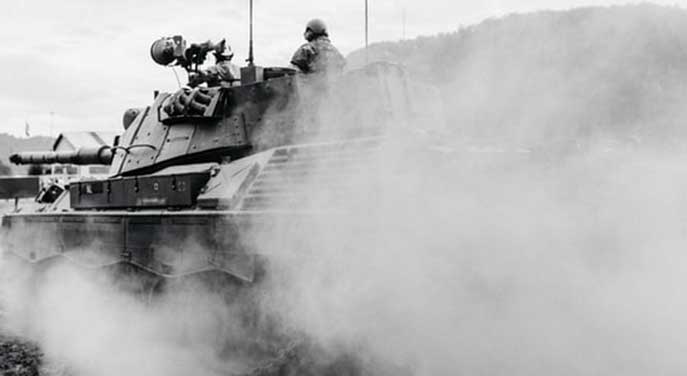 Bordered by Russia to the east and Sweden to the northwest, Finland’s historical experience has been coloured by the existence of these more powerful neighbours. In fact, ‘dominated’ might be more apt.
Bordered by Russia to the east and Sweden to the northwest, Finland’s historical experience has been coloured by the existence of these more powerful neighbours. In fact, ‘dominated’ might be more apt.
After being effectively part of Sweden for centuries, Finland was ceded to the Russian Empire in 1809. But when the chaos surrounding the 1917 Russian Revolution provided the opportunity, the Finns seized the moment and declared independence.
Then along came the Second World War.
For Josef Stalin’s Soviet Union, this was a chance not to be missed. So on Nov. 30, 1939, the Soviets invaded Finland, launching what was to become known as the Winter War. It lasted 105 days.
The Soviets got a lot more than they bargained for. And as Jeffrey Meyers tells the story in a recent Wall Street Journal article, the parallels with the current invasion of Ukraine are downright eerie.
Meyers quotes from the memoirs of Nikita Khrushchev, the man who became Soviet leader after Stalin’s death: “We thought all we had to do was raise our voice a little bit, and the Finns would obey. If that didn’t work, we could fire one shot and the Finns would put up their hands and surrender.”
Just as with Ukraine in 2022, reality was more complicated. The Finns fought back fiercely, and Soviet military inadequacies were exposed. Translating numerical advantage into actual battlefield superiority was a major challenge. Khrushchev said the vaunted Red Army appeared to be “a colossus with feet of clay.”
| RELATED CONTENT |
| Ukraine must be victorious, for all of our sakes By Balkan Devlen |
| Ukraine, Taiwan, and the politics of big neighbour resentment By J. Michael Cole |
| Ukrainians fleeing war face Canadian red tape By Nick Krawetz |
The story Meyers lays out is prescient in terms of what we see today.
Soviet logistics were awful; many of its soldiers were unmotivated, poorly trained conscripts; the Red Army command structure was inflexible and unable to adapt to developing situations; Soviet casualties were vastly disproportionate.
Perhaps the Finnish commander put it best: “I did not think my own men could be so good or that the Russians could be so bad.”
Still, sheer numbers and brute force told in the end. Soviet bombardments simply ground down the opposition and the March 1940 Moscow Peace Treaty ceded about one-ninth of Finland to the Soviet Union.
That, however, wasn’t the end of the story.
When Nazi Germany turned on its erstwhile Soviet ally in the summer of 1941, Finland – seeing a chance to recover its lost lands – partnered with the Germans in what became known as the Continuation War (June 1941 to September 1944). Finnish troops even penetrated pre-1939 Soviet territory and assisted the Germans in the Siege of Leningrad. Then it all fell apart as the Red Army established dominance and the Second World War shifted into its end game.
When it was over, Finland’s 1940 territorial losses were confirmed and extended. What had been its second largest city (Vyborg) was lost, as was around 20 per cent of its industrial capacity.
And a new term – Finlandization – entered the geopolitical lexicon. What it meant was that Finland would remain neutral and be diligently deferential to Soviet sensitivities.
Is this the fate that awaits Ukraine?
With Russia’s focus now reoriented towards the Donbas, it’s not difficult to imagine a situation where sheer numbers and brute force eventually carve out a chunk of eastern and southern Ukraine. And regardless of whether the Ukraine government or anyone in the West chooses to recognize its legitimacy, de facto control has a tendency to ultimately solidify itself.
So yes, it could happen.
But there are significant differences between the 1940s and today.
Back then, Finland was truly alone. Winston Churchill extolled its Winter War heroism, but Britain was in no position to offer assistance, even had it been so inclined. Nobody else was up for it either.
That’s not the case with Ukraine today.
In addition to comprehensive sanctions against Russia, NATO countries – particularly the United States and Britain – are directing substantial amounts of military assistance to Ukraine. Indeed, there are suggestions that the Americans are also providing targeting intelligence. Or, as an observer put it, it’s equivalent to giving someone a gun and aiming it for them, leaving them only to pull the trigger.
Maybe this’ll enable Ukraine to actually win the war, which would be a highly desirable outcome.
Then again – and however inadvertently – Ukraine could wind up losing territory and suffering sustained damage while serving as a NATO proxy to weaken Russia. That’s an entirely different proposition.
Troy Media columnist Pat Murphy casts a history buff’s eye at the goings-on in our world. Never cynical – well, perhaps a little bit.
For interview requests, click here.
The opinions expressed by our columnists and contributors are theirs alone and do not inherently or expressly reflect the views of our publication.
© Troy Media
Troy Media is an editorial content provider to media outlets and its own hosted community news outlets across Canada.

